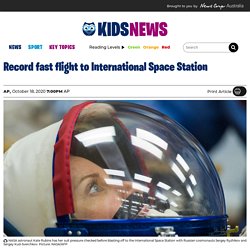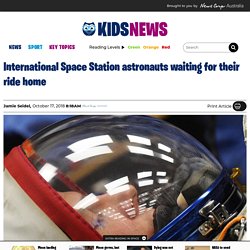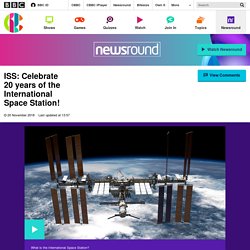

NASA astronaut and Roscosmos cosmonauts arrive at International Space Station on Soyuz rocket that does fast-track rendezvous method to arrive in record time. Three space travellers have arrived at the International Space Station after blasting off on a Russian spacecraft that for the first time used a fast-track manoeuvre* to reach its destination in just over three hours.

NASA astronaut Kate Rubins and Russian cosmonauts Sergey Ryzhikov and Sergey Kud-Sverchkov lifted off as scheduled on October 14 from the Baikonur space launch facility in Kazakhstan for a six-month stint on the station. For the first time, they did a two-orbit approach and docked with the space station in a record three hours and three minutes after lifting-off on a Soyuz rocket. It normally takes about six hours for a Soyuz spacecraft to chase down the International Space Station, and the Soyuz must complete about four orbits around the Earth.
But this time, the Soyuz MS-17 made it in only two orbits, making it the first crewed Soyuz spacecraft to do what is known as the “fast-track rendezvous method”. Reality TV star to win 10-day space trip CLASSROOM ACTIVITIES1. 2. Kids News: International Space Station 20th birthday on November 20, 2018. The International Space Station — one of the world’s most complex technical instruments — turned 20 this week.

This orbiting jigsaw is made up of contributions from 15 countries and has been home to 232 people from 18 countries, which also makes it one of the world’s most successful attempts at international co-operation. To celebrate the ISS’s big birthday, we’ve compiled* a list of 20 things about this space laboratory that are good to know. 1. A Russian rocket launched the Zarya module*, the first piece of the station, from Kazakhstan on November 20, 1998. 2. 3. 4. 5. 6. 7. 8. 9. 10. 11. Kids News: International Space Station astronauts trying to get home to Earth after Russian rocket malfunction. The three astronauts aboard the International Space Station need a ride home and no one is sure how and when they will get one.

They are safe and well but last week’s failed takeoff of a relief crew means they could be there for a while yet. The capsule currently docked at the ISS that could take them home is damaged and no one is confident it would be a safe way to get the astronauts back. German ISS Commander Alexander Gerst, Russian Sergey Prokopyev and American Serena Aunon-Chancellor were due to return to Earth in December.
NASA isn’t expressing concern. “Talked to the crew … they’re doing great,” the deputy astronaut chief, Reid Wiseman, said late last week. They have stocks of food and air for several more months and there are two US and one Japanese cargo-carrying modules about to be boosted into orbit. Air Leak on the International Space Station. ESL Lesson Plan on ISS. International Space Station astronauts waiting for their ride home. The two astronauts on their way to the ISS last week had to eject from their capsule.

Both safely made it back to Earth, but the failure leaves the three already at the ISS without an end date for their stay. ISS mission operations integration* manager Kenny Todd said: “If that’s a month, or if it’s two months, or six — I really can’t speculate* on the length of it.” NASA and Roscosmos — Russia’s equivalent to NASA — are worried about the condition of the Soyuz module currently docked at the ISS.
It passes its use-by date in January. After that, seals and soft parts could begin to break down. The other problem is that there was a small hole in this Soyuz module that had been plugged with glue that became brittle and crumbled, causing a small leak of the space station’s atmosphere in August. A search by the crew found the hole and it was quickly patched up but no one knows whether the heat shield of the landing module is in good condition. NASA astronauts space stroll speculate: guess.
ISS: Celebrate 20 years of the International Space Station! - CBBC Newsround. To enjoy the CBBC Newsround website at its best you will need to have JavaScript turned on.

Is it a bird? Is it a plane? Or is it one of humankind's biggest scientific achievements? Yes, you guessed it!